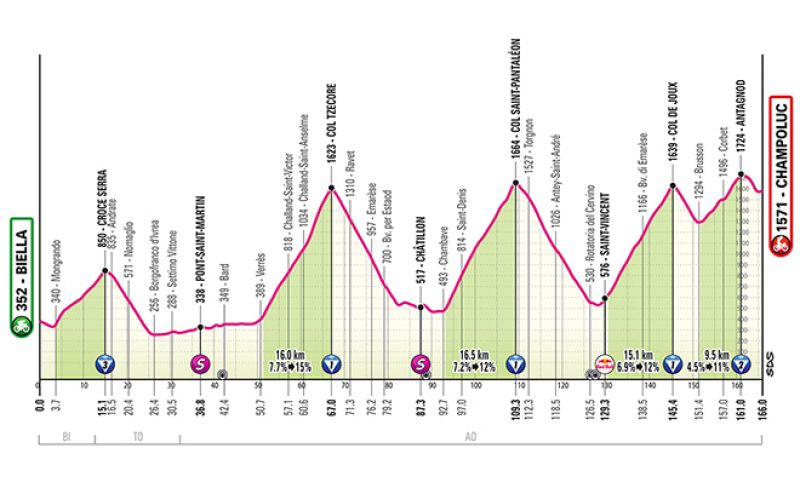

Forgive the play on words: today begins the grand finale of the 108th Giro d'Italia. Stage number 19 takes riders from Biella to Champoluc for 166 km with no less than 4,950 meters of elevation. In short, not a single meter of flat terrain, only climbs and descents.
to follow the live coverage of the entire stage starting at 12:20 PM CLICK HERE
At km 4 the climbing begins immediately at Croce Serra to enter the Dora Baltea valley. Brief false flat until Verrès and then three long climbs of about 15 km each without respite between them. Scaling Col Tzecore (with long stretches over 12% in the last 4 km), Col de St. Pantaléon and Col de Joux. After the descent to Brusson, the final part continues climbing with the passage through Antagnod (gradients up to 11%) ending 5 km from the finish.
About 5 km after Antagnod, the descent begins initially gentle until 3 km where the gradient increases to end with some hairpin turns in the last kilometer in the center of Champoluc.
THE TERRITORY. From Piazzo, the medieval district of Biella accessible by funicular, the view stretches far away. Almost at one's feet, the city center can be observed, which preserves remarkable monuments such as the Baptistery of Saint John the Baptist built on a Roman burial ground starting from the 9th century and the Cathedral of Santo Stefano which takes center stage with all its 15th-century magnificence. Two examples of an important past that ideally lay the foundations of today's vibrant Biella, not by chance named a UNESCO Creative City.
The Cittadellarte - Pistoletto Foundation, located in a former wool mill and established in 1998 by Michelangelo Pistoletto, of whose works a notable permanent exhibition can be admired, is the best synthesis of the city's soul: contemporary art and wool mills. Yes, because Biella is the heart of a top-tier wool district.
Here, and in the surrounding towns, some of the most appreciated and world-renowned Italian wool mills rise, known for the quality of their productions and the elegance of garments unanimously considered leading ambassadors of Made in Italy. A tour of the area's outlets (each company has its own) is recommended.
Shortly after the start, the Giro passes through Mongrando, in whose territory the Special Nature Reserve of Bessa extends, known for the large gold mine that in Roman times was considered the largest in the world. It can be reached from the Vermogno hamlet and also hosts a Gold Museum that recalls its millenary history, showing the equipment used in more recent times by prospectors hunting for precious gold flakes in the Elvo stream bed.
Then here is the Aosta Valley, which immediately presents its rich collection of monuments, historic villages, and castles. The region is entered at Pont-Saint-Martin, proud of its Roman bridge (1st century BC), which still excellently performs the task of crossing the gorge carved by the Lys. Then comes Donnas, behind which long rows of vineyards can be distinguished, giving birth to high-quality wines including the Vallee d'Aoste Doc, the first Valdostan wine to obtain the Controlled Designation of Origin back in 1971.
Then the Bard Fortress fills the view. Well-restored, it can be visited in all its grandeur and is a museum site that also hosts significant temporary exhibitions. A few kilometers through meadows lead to Arnad, the cradle of the renowned PDO lard, a regional gastronomic excellence, but where the gaze is also attracted by the elegant Vallaise Castle. The collection of historic buildings continues in Verres, dominated by the original square-plan manor, and in Saint Vincent with its beautiful liberty architectures. Then comes Chatillon with the Gamba Castle, which houses a notable Modern Art Museum. A stop in the panoramic viewpoints is mandatory before entering the town, offering the best and most convenient view of the Matterhorn.
In Brusson, the Chamousira gold mine offers an experience with few equals, thanks to the careful installations along the galleries from which the precious mineral was extracted. Then it's time to hunt for the delicious Fromadzo, one of the four Valdostan PDOs, produced almost exclusively in Val d'Ayas.
Finally, after crossing the magical village of Antagnod, here is the finish line in Champoluc. The ancient Walser houses and the spectacle of the Monte Rosa peaks covered in ice are worth the journey.
